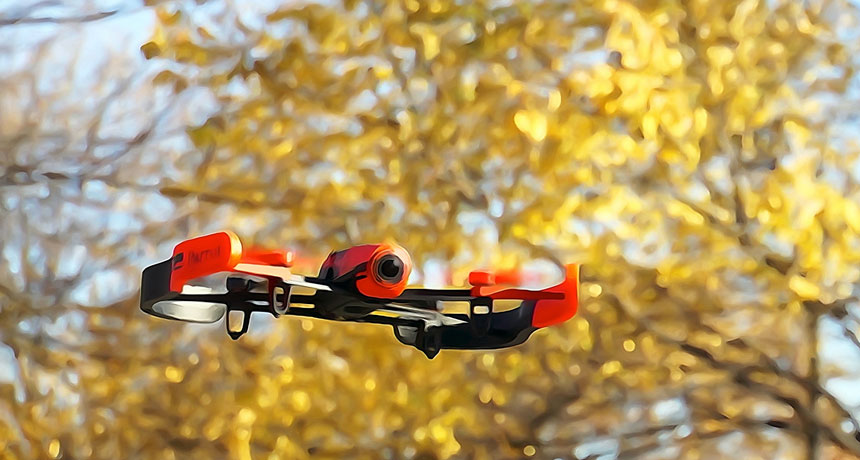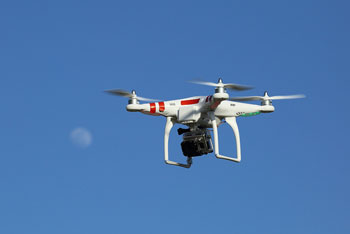Lost in the woods? A drone may find you
Scientists train drone aircraft to follow trails in search of lost hikers

This drone is flying through a park in Washington, D.C. Scientists trained a drone like this one to recognize and travel along hiking trails.
Ted Eytan/Flickr (CC-BY-SA 2.0)
Each year, hikers and mountain bikers get lost or injured in the wilderness. Search and rescue efforts can involve 20 or more people. But a new “smart” drone can follow hiking trails without a pilot’s assistance. This could allow rescuers to search more efficiently, scientists report.
In the United States alone, as many as 34 million hikers hit the trails each year. Some of those trekkers invariably get lost. To find them, a small army of rescuers may scour the woods in search of the missing by foot — and sometimes from the air. Scientists in Switzerland thought these rescue efforts might be better handled by a drone, an aircraft that flies without a pilot on board. Most are remote-controlled. But this Swiss team wanted to develop a craft that could find and search trails without anyone at the controls.
The scientists began with a neural network. That’s a computer program designed to work much as the brain does. A neural network can learn to recognize objects and respond in a particular way when it finds them. In this case, the researchers wanted the network to be able to recognize and follow a trail through the forest.

The team outfitted its craft with a single camera. As the drone’s “eye,” the camera pointed forwards — in the direction the drone traveled. But having an eye wasn’t enough. The drone also needed a “brain” to understand what it was seeing. And that brain would have to recognize what constitutes a trail — the type of path a hiker would likely follow. Camera images, however, can be very difficult for a computer to interpret, Giusti notes. So he and his team used photos of forest trails to train their drone’s neural network.
They attached three GoPro cameras to a single headband. One camera pointed straight forward. The other two were directed 30 degrees to the right and left of center. A hiker donned the package and then hit the trails in a forested part of Switzerland. He was careful to keep his head pointed in the direction of the trail as he hiked. Over several weeks, the cameras recorded a total of 8 hours of video covering 7 kilometers (4.3 miles) of trails.
The researchers then divided the video into individual still images. More than 17,000 of these images were used to train the neural network. The network learned to identify what a trail looked like. And it learned to recognize when the trail was veering off to the left or right.
The team then tested the program with unused frames from the video. At the same time, they had two people classify the photos as being on the trail, to the left of the trail or to the right. Then the team compared the results. The computer did a slightly better job than the people had in correctly classifying the trail. This meant the drone was ready to navigate the real world on its own.
ON THE TRAIL Watch a quadcopter done in action, finding its way along trails through the woods. University of Zurich/SUPSI (Switzerland) |
Giusti and his team took their now “smart” device to a forest with trails that had not been used in the drone’s training. It flew along the path, constantly adjusting its direction based on the images coming in through its camera.
The drone didn’t perform as well in real-life as it did in the lab, Giusti admits. That’s because the drone’s camera took lower-quality images than the cameras that had been used to train it. As a result, the images being taken by the drone looked different, he explains. This confused its neural network.
Narrow trails also proved a challenge. The drone crashed into trees if they were too close to the center of the trail. But on wide trails, the craft could navigate well for a few hundred meters (yards) at a time.
Giusti’s team described the drone’s achievements online December 17 in IEEE Robotics and Automation Letters.
“Seeing and understanding the world around them is exactly what robots are not yet good at doing,” says Giusti. “Neural networks are so good at interpreting images, they will be very useful for giving sight to robots.”
It’s an exciting use for neural networks, agrees Christopher Rasmussen. This computer-vision scientist at the University of Delaware in Newark was not involved with the study. “The results are promising,” he notes. However, the problems encountered in the experiments, such as the image quality and poor navigation, “show that there are still some important issues to be worked out.”
Power Words
(for more about Power Words, click here)
artificial intelligence A type of knowledge-based decision-making exhibited by machines or computers. The term also refers to the field of study in which scientists try to create machines or computer software capable of intelligent behavior.
drone A remote-controlled, pilotless aircraft or missile.
neural network A computer program designed to work in a way similar to the human brain. The programs can “learn” from examples, just as the brain does.







